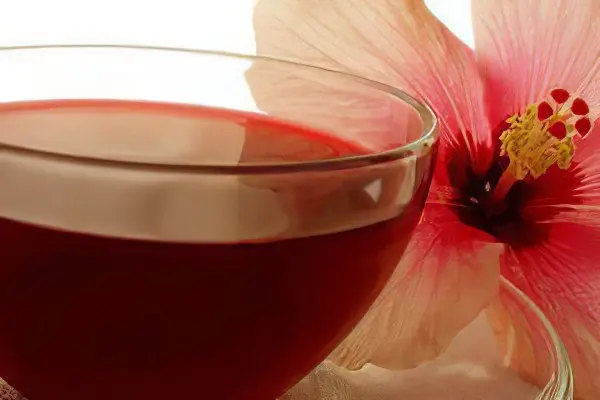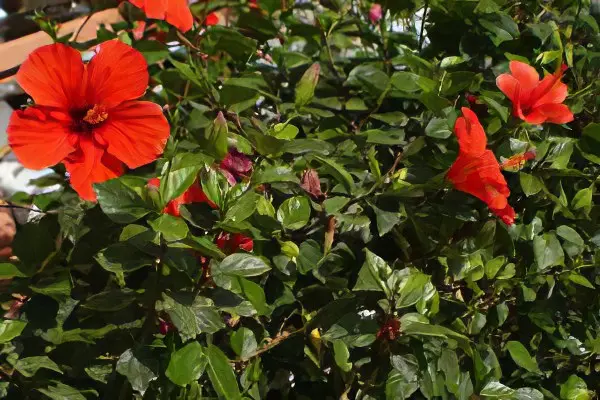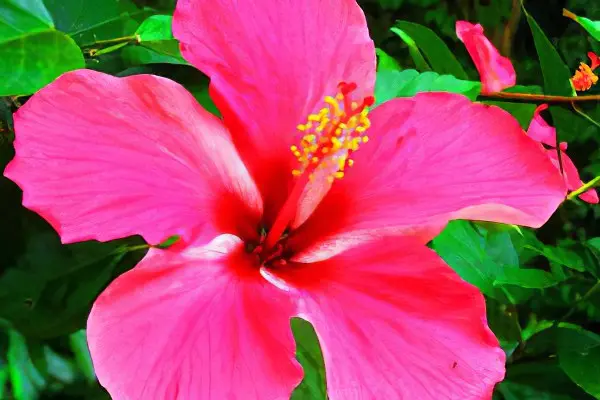Contents
- Useful properties and application of garden hibiscus
- Description of hibiscus
- Useful properties of hibiscus
- Hibiscus tea
- The use of hibiscus
- Hibiscus during pregnancy
- Planting and caring for hibiscus
- hibiscus flowers
- hibiscus leaves
- Reproduction and cultivation of hibiscus
- Hibiscus from seed
- Hibiscus garden
- Hibiscus home
- Varieties and types of hibiscus
- Contraindications hibiscus
Useful properties and application of garden hibiscus
Description of hibiscus

Hibiscus is a very beautiful shrub that grows in various tropical areas. Today, it is often cultivated as an ornamental plant. It can often be found in Egypt, Thailand, Ceylon and Java, as well as Sudan and China. This evergreen deciduous plant has a bare stem. The next leaves are located on petioles. The graceful flowers are quite large. Their brightly colored corollas, located at the top of the shoot, have three leaves in the subcups.
The hibiscus color scheme has a huge number of different combinations. Different types of hibiscus are represented by interesting flowers from 5 to 30 cm in diameter. The hibiscus fruit is in the form of a small box, which breaks up into five original wings. The box contains seeds dressed in fibers or a special fluff. Some plant varieties have bare seeds.
The lifespan of a hibiscus is at least 20 years. It lends itself well to molding. To increase the branching of the shrub, all stems should be cut at the end of winter. Under favorable conditions and with proper care, the plant will reach three meters in height.
Useful properties of hibiscus
The active ingredients of hibiscus are various organic acids, flavonoids, hibiscus acid, anthocyanins, mucus, phytosterols and pectins. The branches of the plant have a sour taste. A drink from this shrub is considered an excellent refreshing agent that perfectly quenches thirst. This healthy red drink has a slight laxative effect on the human body. In ancient times, teas from the plant were used as a bactericidal, anticonvulsant, choleretic and diuretic.
Along with this, it should be noted such properties as anti-inflammatory and hemostatic. Hibiscus is indispensable for the treatment of weeping ulcers.
Hibiscus tea

Delicious hibiscus tea is incredibly beneficial for people of all ages. The substances contained in the flowers of the plant cause an interesting red coloration. Anthocyanins have an amazing P-vitamin activity, due to which the drink perfectly strengthens the walls of blood vessels, while regulating blood pressure and vascular permeability. When hot, this incomparable tea increases blood pressure, and when cold, it lowers it. In addition, the presented drink boasts a powerful antispasmodic effect.
Thanks to the unique composition, tea based on hibiscus flowers not only improves overall well-being, but also improves immunity. The action of anthocyanins enhances quercetin. It helps to cleanse the body of all kinds of toxins, allowing a person to get rid of unnecessary metabolic products. With regular use of tea, bile production is stimulated, and the necessary protection of the liver from external and internal adverse effects increases. At the same time, metabolism is significantly improved.
Drink from hibiscus is able to destroy numerous pathogens, at the same time it fights against various parasites. The pleasant sour taste of hibiscus tea is refreshing in the heat. At elevated body temperature, it contributes to its normalization. Since tea does not contain oxalic acid, it is considered safe for all patients with kidney disease.
A small amount of ascorbic acid is mutually enhanced by the presence of anthocyanins and flavonoids. It may be noted that with a fairly long heating, hibiscus tea may acquire a dirty gray tint due to the decomposition of coloring substances. The undoubted additional advantage of the drink is a slight sedative effect. To prepare this wonderful drink, you will need no more than 400 tbsp per 2 ml of boiling water. l. raw materials.
The use of hibiscus
The beneficial medicinal properties of hibiscus have been discovered since ancient times. It is used to effectively treat not only various diseases of the gastrointestinal tract, but is also used for hemorrhoids, dysentery and acute inflammation of the skin. Various products based on this plant perfectly restore metabolism, since they contain a large amount of flavonoids. They contribute to the removal from the body of harmful impurities formed during the digestion of food.
Hibiscus leaves and flowers have been shown to increase bile production, improve metabolism, and increase liver protection from various harmful effects. The most beautiful flowers of the plant are primarily used as a powerful anti-inflammatory and bactericidal agent. Delicious fragrant teas also have a choleretic and hemostatic effect on the human body. The benefits of crushed to a homogeneous mass of leaves in the treatment of various malignant tumors have been proven.
To get rid of ulcers, extensive wounds and boils, it is recommended to apply pounded hibiscus flowers externally. Drinking tea inside allows you to normalize blood pressure, restore the nervous system and cleanse the kidneys of salts. It has been proven that with alcohol intoxication, such a drink allows you to quickly find good health. Long-term use of various drugs helps men and women fight infertility.
As a preventive measure, various drinks based on hibiscus are prescribed during mass epidemics. Along with this, they reduce the level of cholesterol in the blood and perfectly strengthen the walls of all blood vessels.
Hibiscus during pregnancy
Despite the high content of various vitamins, drinking hibiscus tea during pregnancy can be very unsafe. It significantly increases the risk of various complications. Active active substances of the plant stimulate menstruation, which leads the uterus to tone. Expectant mothers should avoid it.
Planting and caring for hibiscus

For planting this plant, you should choose enough sunny places that are protected from the wind. The landing hole should not be more than 15 liters in volume. It should first be filled with humus, superphosphate and a handful of bone meal. The selected vegetative seedling is placed in a hole along with a root clod of earth.
Hibiscus prefers sunny diffused light without direct rays. Subject to temperature conditions and regular ventilation, it can grow well in a pot on the south side of the house. In winter, shading is not required. The plant does not like drafts. At temperatures below 10 ° C heat, it can shed all the leaves. During the growing season and in the presence of flowering, it is recommended to water it abundantly with settled water, making sure that the topsoil is not overdried.
Humidity does not play a special role in growing hibiscus. However, experienced gardeners advise spraying the plant. This procedure is also a preventive measure against the destructive spider mite. In spring and summer, the plant can be fed with nitrogen-containing mineral fertilizers. If necessary, bushes can be transplanted at the end of April. However, such a procedure should not be more than once every three years.
What causes hibiscus to turn yellow? Often the leaves of the plant turn yellow due to stresses of various origins. The main reasons include insufficient or abundant watering, high or low temperatures, as well as direct sunlight. Dense shade and spider mites can be factors in yellowing foliage.
hibiscus flowers
Large flowers in most species of the presented plant have a rather elegant shape. Their brightly colored corollas, located on the top of the shoots, attract attention at first sight. In diameter, charming single flowers can reach about 10 cm.
Numerous filaments of original golden stamens, which have grown together into a long tube, extend very far from the petals. The color of delicate petals can vary from white to purple. Each flower fades a day after blooming. The abundance of buds makes flowering quite long.
hibiscus leaves
The next leaves of hibiscus are on small petioles. They are often used in folk medicine not only as a mild laxative, but also have a softening effect on coughs.
Reproduction and cultivation of hibiscus
The plant is propagated by cuttings and seeds. To propagate the plant by cuttings, they must be cut in the summer from the tops of the youngest growth. After treatment with growth stimulants, the cuttings should be rooted in indoor greenhouses, where the soil is heated. To form a beautiful bush, you can pinch smaller shoots.
Growing features are based on stimulating the development of numerous shoots formed by flowers. After transplantation, young plants are recommended to be cut to the very kidney at a distance of about 15 cm from the very base. After the formation of new shoots, weak ones must be removed.
Hibiscus from seed
Seeds can be sown in the ground from mid-January to early April. It is recommended to soak them for 12 hours before planting. The earth should consist of a mixture of sand and peat. Keeping the temperature between 25 and 27°C will allow the seeds to sprout quickly. Periodically they should be aired and sprayed. After the formation of three leaves, hibiscus can be transplanted into a pot of the appropriate size. Fruiting seedlings will begin in the third or fourth year of life.
Hibiscus garden
Garden hibiscus is very popular with many gardeners. This fantastic plant has a wide range of interesting shades. Golden stamens give a special charm to funnel-shaped flowers. With sufficient frost resistance, this species is adapted for outdoor growth. Depending on your preferences, you can form an interesting shape of the bush. Flowering occurs from early July to early October.
Hibiscus home
The incomparable indoor hibiscus is unpretentious in care. He prefers brightly lit places, regular watering. He also needs protection from drafts. Beautiful flowers are intended not only for daily contemplation, but also for medicinal use. Thanks to proper care, homemade hibiscus feels great in pots on windowsills and in spacious bright greenhouses.
Varieties and types of hibiscus

Various varieties and types of hibiscus recite about two hundred copies. Interesting hybrid forms are found not only in areas of China and Indonesia, but also in the greenhouses of modern gardeners.
Hibiscus terry. This species is an interesting perennial with a height of no more than two meters. It has large milky white flowers that reach a diameter of 15 cm. This beautiful evergreen shrub has bright green serrated leaves. Each blooming flower fades the next day. To ensure abundant flowering, the plant requires abundant watering, good lighting and a certain temperature.
Hibiscus marsh. This common species has large flowers about 12 cm wide. Each flower is decorated with unusual carmine spots at the base of the corolla. This variety is used by many gardeners to create large shrubs used as hedges. Such an attractive plant requires a lot of light, heat and enough space for full growth. With proper watering and regular pruning, swamp hibiscus can bloom all year round.
Hibiscus white. This excellent plant from the Malvaceae family grows mainly in the tropical regions of exotic Southeast Asia. This plant is distinguished by large flowers of dazzling white color. Delicate flower leaves are framed with an amazing border around the edge. Such a long-blooming perennial is well cultivated in many warm regions. This variety is undemanding to the composition of soils. However, do not forget about regular drainage.
Hibiscus variegated. This modern look of Cooper combines shades of red and white varieties. The predominance of certain shades in the petals of flowers directly depends on the acidity of the soil, the temperature of the content and the degree of illumination. This spectacular plant has large flowers with a long pistil. During the period of active growth of variegated hibiscus, it is recommended to fertilize regularly. The pot should match the size of the plant itself.
Hibiscus red. Such an evergreen plant is found not only on the most beautiful islands of the Pacific Ocean, but will also perfectly decorate your garden. This variety is a particularly very large shrub with large flowers. A lush crown with spreading branches makes it especially charming. Red hibiscus is well propagated by cuttings.
Hibiscus Chinese. It is an elegant evergreen shrub with alternate leaves, which is 15 cm long. Single axillary flowers are on long pedicels. The filaments are fused into a tube. This variety blooms all year round.
Hibiscus Syrian refers to small shrubs. It grows outdoors only in the southernmost regions. This deciduous plant has ovate alternate leaves and delightful exotic flowers. They can be both simple and terry. Many flower stalks make it bloom throughout the year.
Hibiscus tree. Thanks to the large flowers of bright colors, this variety is loved by many modern gardeners. It is used to decorate front gardens as a hedge. The diameter of graceful flowers does not exceed 10 cm. For full flowering, fertile land and regular abundant watering are required.
Contraindications hibiscus
Since hibiscus has a pronounced choleretic effect, it is not recommended for people with serious problems with the gallbladder and urolithiasis. It is contraindicated for children under one year old. For gastritis and ulcers, the appointment of various drugs is possible only after consulting a doctor.









